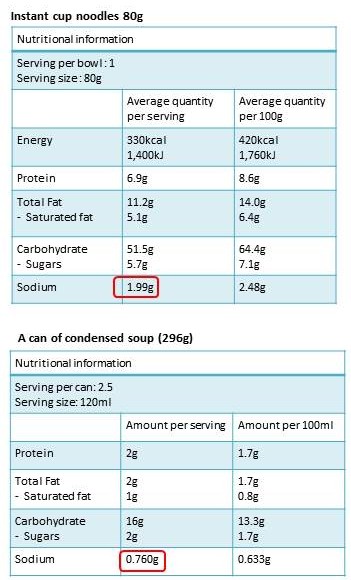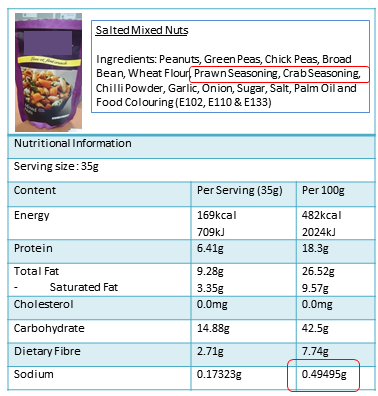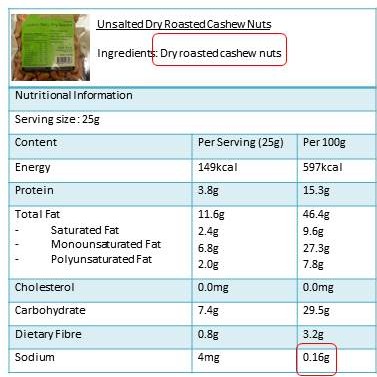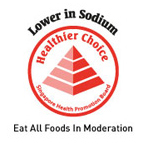
1. What is Salt?
Salt (sodium chloride) contains 40% sodium.
- Sodium is one of the many important substances needed by the human body.
- It is commonly found in sauces (e.g. soy sauce, tomato sauce, chilli sauce and oyster sauce), preservatives and canned food.
- Besides salt, sodium is also found in monosodium glutamate (MSG), baking soda and baking powder.
- In the past, dry edible salt was used to preserve food. Salting was used because most germs cannot survive in a highly salty environment. That was how salted fish, salted vegetables and salted meats came about. Currently, most people have turned to convenience foods, which are foods that are ready to be eaten and do not need much preparation. Examples include instant noodles, preserved cooked meats/vegetables, instant condensed soups, frozen cheese pizza and prepackaged microwavable foods
- These foods are generally lower in nutrients and higher in sodium, fats and sugars. They may have some essential nutrients but these are in small amounts.
2. How does Salt affect us?
A high salt diet may lead to high blood pressure and cause any existing heart failure to become worse.
High blood pressure is a major risk factor for various medical conditions such as stroke and kidney failure. It is important to control your blood pressure to maintain good health.
3. Dietary recommendations
Most adults need only 2g of sodium or less a day. This is about the same as less than one level teaspoon of salt a day.
| Age | Recommended limit (grams) | Teaspoon drawing | Sodium |
| Less than 1 year old | 1 | A tip of the teaspoon | Not more than 0.4g |
| 1 year - 6 years | 2.5 | Half teaspoon | Not more than 1g |
| 7 years - 18 years | 5 | 1 teaspoon | Not more than 2g |
| Above 18 years | 5 | 1 teaspoon | Not more than 2g |
Younger children may need less than one teaspoon of salt. You should also take note of the sodium content in processed food, canned food or sauces.
4. Understanding sodium content in food labels
Examples of the salt content of the different types of "convenience food".
 |
|
Reading the label:
Instant Cup Noodles
Each serving contains 1.99g of sodium which is as high as the daily amount of sodium you are allowed to take.
Condensed Soup
Each serving contains 0.76g of sodium which is more than one third of the amount you should take daily.
Convenience food such as instant noodles and canned soup are high in salt content and should not be taken often.
Salted Mixed Nuts vs Unsalted Dry Roasted Cashew Nuts
Reading food labels also help us to compare between two similar food items.
- When comparing, look at the "per 100g" column instead of the "per serving" column.
- This is because the serving sizes for the two food items are different and therefore cannot be compared directly.
 |
|
In this packet of Salted Mixed Nuts, prawn seasoning and crab seasoning also contain sodium. This is in addition to the salt listed in the ingredients listing.
For every 100g of salted mixed nuts we eat, we are taking in a about 0.5g of sodium.
If we replace it with unsalted nuts like cashew nuts, the salt intake can be lower.
 |
|
For every 100g of unsalted cashew nuts we eat, we are taking in 0.16g of salt.
Do note that cashew nuts have more fat than mixed nuts and should not be eaten excessively.
5. Tips to cut down the amount of Salt you take
- Choose foods that have Less or No Sodium.
- Alternatively, use less of the seasonings if these are provided separately with the convenience food.
- Eat fresh food instead of processed and / or preserved food.
- Ask for less gravy and sauce when you buy food with gravy. Or you could simply eat less of the gravy.
- Use natural herbs and spices for flavouring when cooking, instead of salt and monosodium glutamate.
 |
|
.png)



















































